GoPro was once the only option when shopping for an action camera. Certainly, GoPro revolutionised, if not Discovered, the action camera business, and for a while, they dominated the entire industry.
But those days are long gone; there are now many viable alternatives to GoPro. The marketplace for action cameras has grown substantially, and GoPro’s rivals have recently shown that they may be a formidable threat.
However, there is a myriad of subpar alternative solutions on the market. And nothing is as irritating as falling for scams or buying a low-quality camera.
That’s why this article has compiled this excellent roundup of the top GoPro substitutes to get you started. This article will cover 12 incredible action cameras and explain why they are all worthy substitutes for the GoPro.
Furthermore, it’ll give you a firm grasp of the most suitable action camera for your needs and budget.
How to Take Quality Content Using an Action Camera
High-quality action cameras can help you capture all of life’s greatest moments. But are you knowledgeable enough in photography and storytelling to fully take advantage of these cameras’ exceptional features?
Any amateur adventure photographer would benefit greatly from enrolling in the Roam Academy, particularly Cory Richards’s Photography course.
12 Excellent GoPro Alternatives in 2022
Here are the 12 best alternatives to GoPro that you can buy. Towards the end of this post, you’ll learn about what professionals look for in an action camera.
#1. Akaso Brave 4
#2. OCLU Action Camera
#3. Yi 4k +
#4. Garmin VIRB Ultra 30
#5. Sony FDR X3000R
#6. SJCAM SJ7 Star
#7. Garmin VIRB 360
The Best GoPro Alternatives of 2022
Let’s face it: many of these GoPro replacements are good, but the real thing (GoPro) is still the best. Like Coca-Cola, the classic GoPro remains the greatest, and it might be a good investment for people who can afford the extra cash. With a good GoPro, you can go on adventures for many miles and a very long time without buying a new action camera or even repairing it regularly.
Here are the best alternatives for GoPro available in the market in 2022:

1. Akaso Brave 4
The Brave 7 LE is Akaso’s most recent and best budget action camera; it is less expensive than the GoPro cameras in the market. This camera offers 4k recording, a remote control, simultaneous recording on two screens, and a few extra batteries for about $80, making the deal even better.
Your best GoPro substitute is the Akaso Brave 4 LE if you’re looking for a highly affordable action camera that still produces top-quality photos.
This camera’s resolution may be recorded at up to 30 frames per second, a considerable edge for adventurers. You can achieve higher frame rates at low solutions, but the highest possible frame rate at 720p is 120 fps.
This camera’s built-in electronic image stabiliser aids in eliminating shakes and producing smooth videos, but it is not as perfect as other action cams in this review. This model’s microphone is inferior to that of a GoPro. Luckily, sound quality continues improving on the latest Akaso model, and it’s predicted to improve.
The Brave 4’s integrated remote may initiate and manage recording sessions. Although it lacks advanced capabilities like a live video feed, this remote controls your TV just fine. Wireless Internet access (WiFi) is built for app-based phone connectivity (iSmart Pro Plus).
The AkasoBrave 4 features a touchscreen besides the standard USB and HDMI connectors. The camera can withstand water depths of up to one meter without this supplied case and up to 30 meters with the unique cover.
You’ll need to buy one individually if you want to use an SD card on the Brave 4 LE. Spare batteries are included, helping balance off the cost of an SD card. An assortment of mounts and accessories are also provided for the camera.
Pros
- Excellent 4K videos
- Dual screens
- Pocket friendly
Cons
- Average sound quality
- Doesn’t have an SD card
- The quality is limited above 30 fps
2. OCLU Action Camera
The OCLU action camera is your go-to option if you’re looking for a ready-to-use 4K camera that can start shooting professional-quality film immediately. This camera has been making headlines for a while now thanks to its innovative design and affordable price.
The popularity of the OCLU camera is because it has everything you’ll need to capture beautiful life moments, plus some nifty extras that are only available.
You may organise your footage as you go when using Live Cut, keeping only the finest takes for post-production. Moreover, the camera allows you to control it via an app, simplifying switching between the various shooting modes and adjustments. As for frame rates, many of us probably wouldn’t need to be filming in 4k every time, but at 1080P @ 30 / 60 FPS, optical viewfinders are super smooth.
The camera can record 4K video at 30 frames per second.
OCLU’s compatible size makes it a great choice if you value portability. However, its irregular shape may take some time to get used to.
The camera has unique extras like a waterproof enclosure, activity-specific helmet and body mounts, and an extendable grip mounting. The camera can be submerged to a depth of up to 50 meters (165 feet) without leaking (50m).
Moreover, it has a GPS tracker, helping you keep track of your whereabouts on all your travels.
To sum up, this camera is worth every penny you spend.
Pros
- Supports different types of recording modes, including burst, timelapse, and loop
- OCLU is convenient because it is mount-compatible
- Live cut editing
Cons
- It doesn’t have image stabilisation in 4k
- It takes fewer pictures than other cameras
- It needs a different case to be completely waterproof
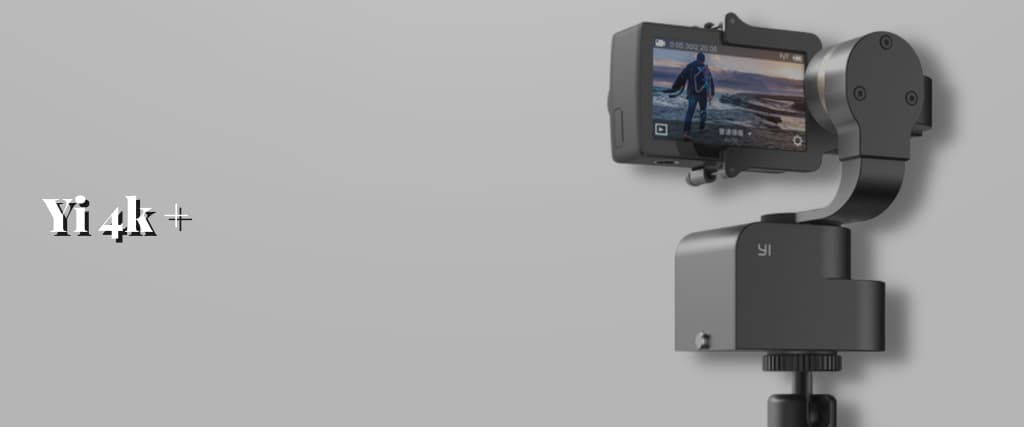
3. Yi 4k +
The Yi 4k+ is almost as good as many GoPros, but still, it costs nearly half as much. This camera option is an excellent low-cost GoPro substitute for many reasons. For example, it has a rugged touchscreen, can record in 4k, and has a long battery life.
From an electro-optic standpoint, the Yi 4k+ is almost as good as GoPros. Besides, the visuals are clear and as good as the ones in the GoPro HERO4.
Also, you can record 4k films at 30 frames per second, as the name suggests. At 720p, you can get 240 fps. The Yi has electronic visual stabilisation, yet it could be more impressive than most other electro-optical stabilisation solutions.
On the other hand, the Yi 4k+ doesn’t have as many shooting styles as a GoPro, but it can still take time-lapse and slow-motion videos. The Yi 4k+ takes very nice pictures that are remarkably free of chromatic aberrations, vignetting, and other types of distortion. Thanks to the in-camera fixes, there aren’t any of these flaws.
The Yi 4k’s construction is almost similar to GoPro’s: it’s rugged, compact, and reasonably functional. The uniqueness of the Yi 4k + is its giant touchscreen, where you can adjust most of its settings. The touchscreen’s responsiveness and aesthetic appeal are compromised under direct sunlight. It would have been good to have extra mechanical buttons to play with.
The Yi 4k+’s excellent battery life is one of this camera’s many advantages. In terms of recording duration at all resolutions, it comfortably outperforms the GoPro HERO4. This Yi 4k can continue recording for more than 90 minutes.
However, you’ll need to consider a few drawbacks that come with this fantastic action camera.
For example, there are no extras, not even a waterproof case, for the Yi 4k + cameras. Plus, all accessories for this cheap GoPro cam alternative must be purchased individually, which may be a dealbreaker for some.
Pros
- Excellent 4k video recordings
- Big touchscreen
- Superb battery life
Cons
- There are no add-ons, such as a waterproof case
- Touchscreen dependence reduces usability
- It has fewer bells and whistles than a GoPro

4. Garmin VIRB Ultra 30
This camera is among the top pick alternatives for the GoPro. Garmin VIRB Ultra 30 has impressive features like its robust build, high-quality video, and numerous cutting-edge features like speech recognition and helpful overlays.
There is not much to criticise about this camera’s construction. Moreover, it’s compact, has a durable exterior and responsive touchscreen, but requires additional accessories to function fully.
Although the VIRB is not inherently watertight, you can make it so by attaching an additional housing rated to a depth of up to 131 feet. And even with the casing in place, the voice and touch screen and voice commands continue to function flawlessly.
This Garmin cam also excels in video quality and filming options. It’s the first Garmin product to support 4k videos at 30 frames per second. Other resolutions and frame rates are available for recording, such as 720p at 240fps, 1080p at 120fps, etc. The recording quality is exceptional, with vibrant colours and sharp clarity, readily rivalling that of the newest GoPro versions.
While this Garmin camera’s voice control option does a good job overall, it could be flawless. WiFi is built in, allowing you to link the cam with your smartphone and view live videos from YouTube.
Its G-Metrix system allows users to also put several metrics on top of their videos, such as pulse rate and the distance travelled.
However, the VIRB Ultra has its shortcomings. For example, there have been complaints that 4k lasts less than an hour due to the camera’s low battery life. This drawback is especially noticeable when the camera’s more resource-intensive features are employed.
The batteries are easily accessible and may be swapped out while you’re on the go. While it’s great that there’s built-in picture stabilisation, it’s electronic and only sometimes very reliable.
Pros
- The G-Metrix framework and suitable voice identification make for excellent connectivity
- The G-Metrix framework and suitable voice identification make for excellent connectivity
- It is compatible with GoPro accessories and mounts
- Excellent video and picture quality
Cons
- Shorter battery life
- Weak image stabilisation
- It will need an extra casing to be waterproof

5. Sony FDR X3000R
The camera’s high-definition video, convenient Live Focus Control, and built-in image stabilisation are remarkable. If you can afford to spend more, this camera from Sony is the most superior quality alternative; it’s an excellent performer.
While it comes with a heftier price tag, this cam captures commensurately superior-quality videos. It can shoot at 4k resolution. The video and images are sharper and smoother, thanks to the incredibly effective image stabilisation system. However, the camera’s bullet form limits its portability compared to more conventionally cuboid action cams.
The X3000R cam has a built-in 3-axis mounting system, compatible with GoPro extras, giving you many options.
Unfortunately, it is only water resistant to the point of splashing, and you’ll need an additional case for use in the deep waters. You may use this action camera in depths of up to 197 feet with an additional case.
The X3000R action camera is one of the few action cams to include a detachable Live View Control that can be attached to a surface, such as a wrist or a bike handle. These steps will help you avoid interrupting recordings while watching the live feed.
While the idea behind this control is sound, connectivity issues may arise in practice. PlayMemories is a phone app connected to the FDR X3000R through the camera’s in-built WiFi and serves as a virtual remote control.
This action camera’s short battery life is another huge drawback. But you can swap out the batteries, so bring a few extras if you plan on shooting all day. The camera’s still image quality is also lacking.
Pros
- Superb picture stabilisation
- Top video quality
- Live View Remote.
Cons
- The quality of the still images was subpar
- Less time between charges
- Extremely high cost

6. SJCAM SJ7 Star
Like the Yi 4k +, this cam simplifies and cheapens many of GoPro’s defining features. It is a strong choice for the top action camera because of its excellent 4k filming and touchscreen.
It provides the typical video qualities found in 4k cameras today. It has a 4k recording option, and the maximum frame rate is 30 fps. 720p can record at 240 fps. The videos shot with the SJCAM are of satisfactory quality and have not been the source of any problems. The standard electrical (Gyro) picture stabilisation is adequate but less suitable than mechanical alternatives.
This cam’s external body is constructed from aluminium, making it reasonably robust. However, the processor overheating during extended usage might cause the camera’s body to become dangerously hot. In addition to triggering catastrophic failure, this overheating issue can reduce your battery’s life and make the camera uncomfortable to hold.
LCD panels are accessible through the back touchscreen and house most of the camera’s menus and settings. The back touchscreen is snappy, although it is easily blinded by sunlight in bright environments. The only controls for the front cam are the power and settings buttons.
SJCAM isn’t waterproof without a customised casing, which can support it up to 100 feet deep. The camera comes with a case and several extra accessories.
Noticeably, the camera lacks a tripod screw on its base, which is strange given that it is a feature nearly all cameras have these days.
Pros
- Superb 4k video filming
- Superior image stabilisation.
- Pocket-friendly prices
Cons
- Its aluminium body often overheats
- Lacks tripod mounting system
- It can have the usual touchscreen frustrations
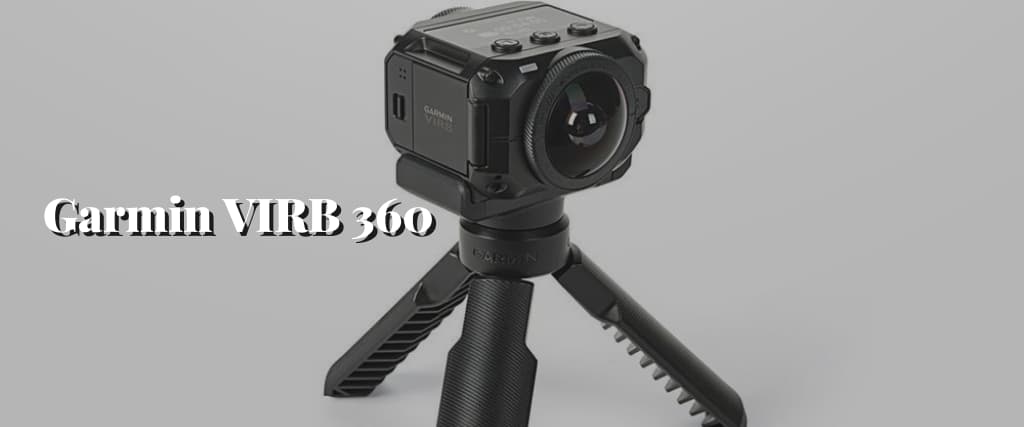
7. Garmin VIRB 360
This cam is your best bet if you want to try out a 360 cam but still need something sturdy and reliable, and it goes for just around $1,000. VIRB is the most incredible 360-action cam due to its high-quality optics, ability to film in 5.7k, and affordable price.
An all-around (or “360”) camera captures footage in all directions. VIRB 360 produces very realistic videos, which have been praised as the forerunner to virtual reality. Unfortunately, due to technical limitations, most video-viewing platforms like YouTube still can’t accurately make 360-degree footage. In any case, people searching for a fresh and exciting take on photography try out 360 cameras, which is a worthwhile investment.
The optics of the VIRB cam are top-notch. It’s famous for recording video at 5.7k, a higher definition than the GoPro Hybrid. Its resolution has yet to catch on to the point that 360 films can be shown correctly, but 360 clip quality is evident nonetheless.
This VIRB 360 is a powerful 360-degree camera and can also capture standard 4k footage at 30 frames per second (fps) and 720p films at 120 fps.
Merging many images is required to generate a complete 360 video. VIRB camera users can accomplish this in person or with the help of additional software.
However, you can only edit 5.7k in-body 360 films produced with this cam with the help of additional applications.
It’s a top-notch Garmin camera in every aspect. The camera may be used underwater for up to 100 ft without needing a particular case and is generally quite sturdy. This VIRB interface is also basic, with just a few controls and an LCD for setting and reviewing settings.
Like most Garmin products, it has a variety of sensors that log data like motion, altitude, and GPS locations.
Pros
- Can film 5.7k. Videos
- Extremely sturdy and watertight.
- Reasonable price tag.
Cons
- stitching 5.7k is often hard
- are expensive when compared to other action cameras.
- Short battery lifespan
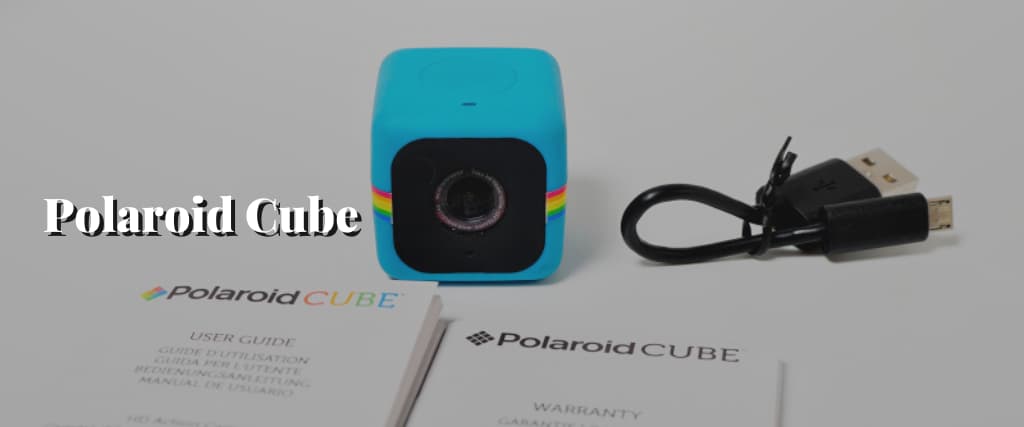
8. Polaroid Cube
This cam is one of the tiniest action cameras; it weighs less than 2 ounces and measures slightly less than one and a half inches on all sides. This adventure camera’s cheap cost and high-quality (1080p) video capture will make it a hit with any action cam enthusiasts.
Its performance is respectable, especially considering its compact design. However, the footage quality is poor compared to most cameras in this guide, even at 1080p. When the tiny sensors and slow bitrate (8 Mbps) are considered, efficiency can be subpar at best. The outcome can still look good under the right circumstances; enough light, less motion, etc.
Even though its recording quality could be better, the rest of the product is exceptionally well made. This cam can withstand being hurled, dropped, and some beat-ups, just like action cameras should. This Polaroid cam is not waterproof; you will need a separate housing if you plan to record underwater.
Also, this cam has a magnetic base, which can be attached to any metallic surface.
The Cube’s lone button serves as the shutter release, video record start option, and power button. The lack of a live view screen means you’ll have to shoot in the dark.
It has a relatively short battery lifespan; worse, it is in-build. The batteries can be removed from the cube and replaced by the user, but this will require some effort on the user’s part. Recordings on the Cube can be at most five minutes; thus, lengthier recordings probably would only work sometimes.
Pros
- Incredibly small; very portable
- Pocket friendly
- Quality video
Cons
- Short lifespan and non-interchangeable batteries
- More focus on innovation than on practicality.
- Limited features
9. Sony DSC-RX0
The DSC-RX0 camera option is for buyers looking for alternative action cameras that will give them a new shooting experience. This camera from Sony is more like a tiny hybrid camera and less of an action camera, thanks to its more appropriate Aperture and superior optics. However, it is still a top-tier option for an action camera.
DSC-RX0 has a beautiful Zeiss lens with exceptional optical properties; the 24mm f/4.0 aperture is its vital selling point. This cam captures clear, high-contrast shots. It has a peak image resolution (15.3 megapixels), allowing users to capture more details. While the f/4.0 aperture is sluggish and may not significantly add to low light quality, the bigger image sensor performs a decent job of managing noise.
The DSC-RX0’s field of view is noticeably smaller than that of a standard action camera, clocking in at 24mm (FF equivalent). The DSC-RX0’s framing, unlike many action cams, is far more conventional and pleasing to the eye of the photographer, which will please those who dislike the fisheye effects. The DSC-RX0 cannot record the kinds of massive scenes that have made GoPros so popular among athletic events.
Regarding video capturing, this cam is in its league. However, If you want to film in 4k, you’ll need an external power recording device, although you can record in full HD at 100 frames per second. It may give up some video quality for improved still photography.
While the DSC-RX0 camera has a more traditional camera feel on its lenses, its build is nonetheless dedicated to action. The DSC-RX0 is waterproof and incredibly compact. Several connections are available for connecting optional extras such as HDMI cable, compact travel gear, or microphone.
Pros
- First-rate picture quality
- Utterly impervious to water.
- Small size; portable
Cons
- Expensive
- There’s no built-in support for 4K recording.
- Limited field of view
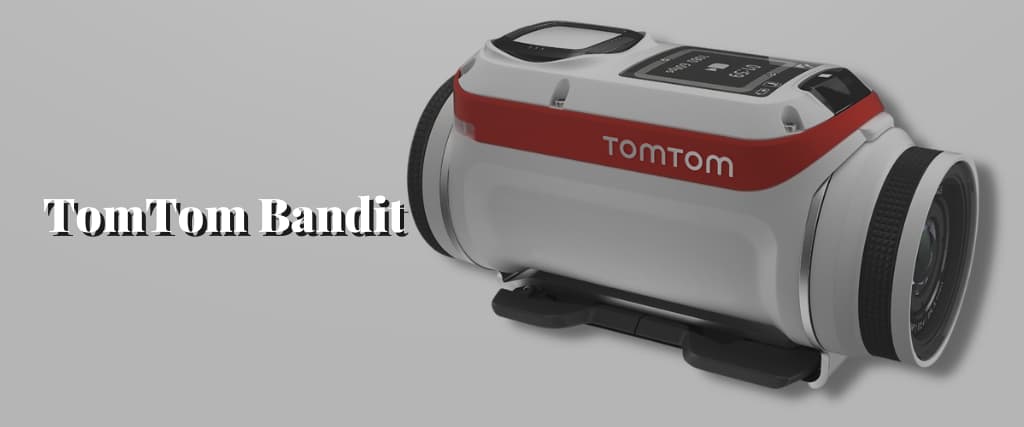
10. TomTom Bandit
TomTom has made an impressive debut in the adventure camera market. This camera is a superb substitute for the GoPro that falls just short of recognition due to its durable build, excellent use, and is compatible with GoPro accessories.
While its front lens components are not waterproof, the rest of this camera’s body is. Generally, Bandit cameras are only waterproof to a depth of 66 ft, but this version may be made waterproof to depths of about 131 ft by replacing the basic lens cover with a “dive” lens.
TomTom Bandit cam stands out because it is easy to operate and well-connected. The LCD and on-camera controls make it a breeze to set.
Its onboard controls are likewise intuitive, making it a breeze to make adjustments.
This Bandit smartphone app is superior to competitors. The application stores some crucial metrics, provides the standard remote shot controls and is also a fantastic tool for video editing processes. With the help of the application’s built-in GPS and sensors, users can record and analyse essential data like G-Force, speed, and rotation while they shoot.
The quality of its videos could be better. Users can achieve a maximum of 15 frames per second in 4k. You are better off recording in 1080p or 720p at 120 frames per second.
As a result of using less power-hungry recording technology, the Bandit’s battery capacity is superior to that of nearly all action cameras in this list. If the WiFi is disabled, your Bandit can keep shooting for almost three hours, though at lesser resolutions. Its battery compartment is accessible by twisting off the device’s back, which reveals a USB port for charging and data transfer.
Pros
- Simple to operate.
- Superb accessibility
- Incredibly long battery life.
Cons
- Produces average pictures and video
- It needs a dive case to go in water depths beyond 131 ft.
- It doesn’t come with all accessories
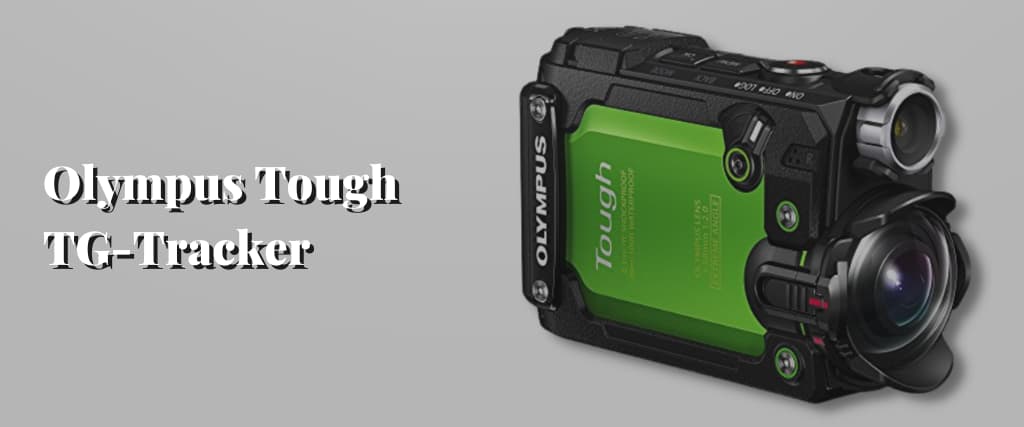
11. Olympus Tough TG-Tracker
This camera has a high-quality build and extensive capabilities, making it a top-tier action camera. This Olympus action camera comes with a bullet shape and is the lightest of these bullet-shaped cameras at just 180 grams.
This little camera is already watertight, so there’s no need to bulk it up with additional housing. However, the lens may need a sizable waterproof casing for complete waterproofing.
The TG-Tracker is simplistic and intuitive, even for newbies. This camera’s body features several buttons for accessing menus and beginning recordings. Like most video recorders, the LCD swings out; however, you can’t rotate it. It also allows you to use the LED light in low-light conditions.
The TG-Tracker’s features, like 4K resolution, 240 frames per second (fps) at 720p, and picture stabilisation, enable you to produce high-quality videos. Furthermore, the 8-megapixel sensor has good still shots without sharpness and contrast.
Its FOV (field of view) is 204 degrees, making it even broader than the GoPro’s. However, some people may feel that the fish-eye effect is overdone. And while the TG-Tracker’s FOV can be altered through the menus, they are hidden somewhat.
Its most laudable qualities include this camera’s incorporation of a high-quality GPS and many sensor systems. The TG-Tracker’s array of sensors allows it to capture more details than all action cameras on this roundup. Temperatures, pressure, altitude, location via global positioning system, and much more fall into this category.
Pros
- Superior sensors
- Fully waterproof; you don’t need a case
- Great performance
Cons
- Its smartphone app is complicated
- The lens is too big, making the changing field of view hard
- Not smaller than GoPro

12. Olfi One.Five
The Olfi One.Five camera is among the most user-friendly and reasonably priced action cameras. It is a fantastic alternative substitute to the GoPro due to its high quality, low price, and extensive features.
While this camera’s quality is impressive, it needs to improve in several key areas. For example, while it has a frame rate of about 24 frames per second is commendable at 4k, the definition is interpolated.
On the opposite end of the spectrum, this camera can reach a dismal 120 frames per second at 720p. Given the device’s compact form factor and relatively high price tag, it’s understandable that users might excuse its video performance.
The camera has an extraordinary appearance. Its body is flatter than cube-shaped, making it look like a miniature remote control. The Olfi’s structural integrity feels very strong, and despite the impression it gives of being easily broken, it holds up surprisingly well. You’ll need to buy additional housing if you want it to be completely watertight.
This camera’s user-friendliness stems in large part from its intuitive interface. The design is simple, with only a few keys and an LCD that, unlike many other cameras, is usable even in bright sunshine. Simple to use, it’s easy to make adjustments with the device’s built-in menus.
However, it needs to excel at connectivity. This camcorder has the standard connectors and a WiFi adaptor; however, it lacks significant supplementary software. The mobile application’s interface could be better, and the editing software could be more impressive.
Pros
- Affordable
- User-friendly
- Smaller than a GoPro.
Cons
- Its battery life is not great
- Some people may not be wowed by 4K or frame rates above 30 fps
- the camera manufacturers should improve the editing and accompanying applications
13. iSaw Edge
The iSaw Edge action camera option saves you money if you can’t afford the GoPro models. Like cameras on this guide, this camera comes with exceptional features that are superb for adventure.
This camera has excellent optical quality, and the quality of the video and pics is fantastic. In 4k, the iSaw cameras can only manage ten frames per second. The highest frame rate it can achieve is 120 fps in 720p.
iSaw camera owners have an edge when it comes to durability and mobility. The iSaw Edge is roughly the same size as a GoPro when removed from its protective casing. The iSaw Edge, when contained in its container, can withstand depths of up to 130 feet without sustaining damage.
The camera’s overall simplicity makes it a joy to use. Its three buttons (power, shutter, and mode) are intuitively placed and serve various purposes. There’s also a touchscreen LCD; however, it has the typical glare issues of its kind.
You can achieve two hours of video recordings before the battery needs to be recharged. If you enjoy shooting dashboard films, you’ll be happy to know that its battery can be swapped out and recharged as you drive.
The iSaw cam is packaged with a wide variety of attachment hardware. The cam is also compatible with GoPro extras, giving users access to a more extensive accessory selection.
Live Viewing and remote are also features of the Edge phone app. The app needs to be more consistent and maintain its connection with the cam.
Pros
- Affordable
- Excellent video quality
- Compatible with GoPro accessories
Cons
- Inadequate frame rate, especially with 4K
- The app on my phone isn’t working
- Not unique
Things to Consider When Shopping for an Action Camera
The process of purchasing an action camera or a comparable substitute to the GoPro is slightly different from that of a standard DSLR. Factors like size, weight, sensor quality, etc., are still considered, but other factors are given more weight.
The most crucial aspects of a camera system are its video recording capabilities, toughness, and battery capacity. Simply said, a high-quality action camera can record for longer and in more challenging lighting. Other properties like the camera’s accountability and built-in WiFi may be necessary based on your visual style.
I’ve compiled a few points to consider before purchasing an action camera. You should consider these when deciding which option GoPro is best for you.
Video Resolution
The video quality of today’s action cam can be anything from amateur to expert. There are some pretty wild cameras out there, especially with the numerous recent technology advancements like picture stabilisation and a customisable field of viewpoints.
Currently, 4k is the best resolution for video recording. Several action cameras offer 4k recording capabilities, and while the resulting videos have fewer megapixels, they are still stunning. Even if 4k isn’t an option, all of the action cameras discussed here can record in 1080p (HD quality). Ensure you know why you need 4k in the first instance; if you will only ever view your videos on a 1080p display, then all that extra resolution is for naught.
When searching for a suitable replacement for the GoPro, it’s also essential to consider the frame rate. In today’s world, 30 frames per second are the norm for cameras. The historical standard for filmmaking, 25 frames per second, produces a beautiful “movie” aesthetic.
It’s becoming increasingly common to record at 60 frames per second, 120 frames per second, and even 240 frames per second, all producing nicer slow-motion recordings at higher fps.
Construction and Durability
It’s crucial to look for durable action cam that can withstand rough treatment if you plan on using them for any extended period—comfortably placing the cameras on your shoulder or whichever object can make your shooting experience memorable.
Most modern action cameras are sturdy and can withstand significant abuse. The quality of their construction determines how well they withstand stress.
The awe-inspiring aspect is the depth to which an action cam may be immersed before water damage occurs. While most cams have a maximum depth of 150 ft., others can go as deep as 30 feet. These figures have additional significance if you are a deep-sea diver.
There is a little learning curve when figuring out how much and how big an action camera should be. The more compact and portable an item is, the greater its utility. Many cheaper action cameras are constructed from inexpensive materials and are more likely to break.
There are two common forms of action cameras: the cube and the bullet. The most prevalent shape is a cube, which is also one of the most practical. However, some people like bullet-shaped cameras, and because of their more prominent form factor, they tend to have more advanced technology and functionality.
Ergonomics and Connectivity
Action cameras have a reputation for being difficult to operate due to their compact design and few buttons. The makers of today’s action cameras have solved this issue to some extent with the help of some surprisingly simple technology.
The use of touch screens is becoming more frequent and is generally beneficial. These are preferable to having and learning to utilise the camera’s manual settings since they eliminate the necessity for such environments. Voice controls are becoming more common, and while they are still immature and imperfect, they are an encouraging development.
Today, an action camera is only considered fully functional if it has WiFi connectivity. Connecting your action camera to a smartphone or other electronic device enables wireless image sharing and remote photography. Even though most (if not all) action cameras include WiFi connectivity, not all are equally effective. When shopping for an action camera, consider how well it communicates wirelessly.
Battery Life
Having your action camera die during the most exciting moment of a scenario you’ve been capturing is one of the most aggravating things that can happen. If your camcorder takes a short while of shooting and dies, all of the 4K and slow-motion footage will be for waste. It’s, thus, crucial that you think about the battery life of your camera option.
If you’re recording continually, many action cameras will die after around three hours. Most camera manufacturers conceal the actual battery life for commercial reasons. It might be challenging to make an informed decision about an action camera solely based on only specifications.
The safest approach is to read or listen to comments and go with the general opinion.
Shooting video at a higher frame rate, in more excellent resolution, or using wireless connectivity can shorten your battery’s life. Consequently, better batteries with a longer lifespan are necessary for more excellent cameras with more cutting-edge technologies. Specific budget cameras may have longer battery lives because they use less power-hungry technology.
Nowadays, several action cameras feature interchangeable batteries that can quickly swap out in the field. You should buy extra batteries if you want to shoot for extended periods. It is possible to send the battery for an action camera to a 3rd person for restoration if they are different. You can have these services for a wide range of prices, most of which are fair.
FOV/Image Stabilization
The FOV of most camcorders is anywhere from 140 to 170 °, which is around 17mm-20mm on a full-frame camera. However, others allow you to toggle between several different viewing angles. Remember that the fisheye effect is typically a symptom of these broad angles (which are used to gather much information). Though, most editing programs have a way to fix fish eyeing.
Action cameras now have a newer sort of technology called image stabilisation. Simply put, IS (image stabilisation) smooths footage by compensating for an unsteady camera. Also, users may take advantage of a machine to achieve this or simply use an electronic device. It’s also worth noting that cameras with IS technology are usually more expensive.
Accessories
Action cameras are more practical to extreme camera operators and athletes when they have a complete set of accessories they may need. The ability to set up the camera fast and efficiently is crucial to a satisfying filming session because it is hard to carry the camera every time, mainly if your hands are complete with others.
Features like weight, size, shape and the availability of the appropriate mount are all factors to consider before committing to adventures like travelling with drones, surfing, or bike riding. Look through the catalogues of each manufacturer to find the mounting and extras that work with your specific model.
Some of these cams may even be backwards-compatible with GoPro’s existing lineup. Several third-party manufacturers make mounts and extras that may work with your GoPro alternative.
You may need additional housing for submerging some action cameras. In highly unusual circumstances, a camera may be compromised at depths much shallower than the 33 feet to which it is rated. Having some more defence against liquid can be helpful.
Value
Ultimately, the price you’re willing to pay for a suitable substitute for your action camera will determine your options. In today’s market, you can find cameras in a wide range of sizes and prices. Doing homework can help you choose the best action cams for your needs and budget.
